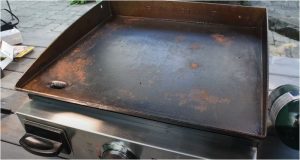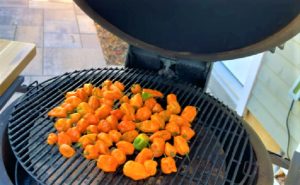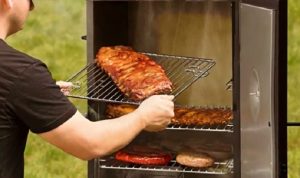Blue Smoke vs. White Smoke: A Battle of BBQ Techniques
Blue smoke and white smoke are two distinct signals in the BBQ world. The former is often associated with a well-managed fire and optimal flavor, while the latter can indicate issues with temperature control or fuel quality.
Blue smoke is the gold standard in BBQ smoking. It’s a sign of a clean-burning fire, often achieved with high-quality charcoal. This ‘good smoke’ imparts a desirable flavor to the meat, enhancing its natural taste. Achieving blue smoke from a smoker requires careful management of airflow and fuel.
For electric smokers, maintaining a steady temperature and using well-seasoned wood can help produce the coveted thin blue smoke.
White smoke, on the other hand, is often seen as ‘bad smoke’ in BBQ. It can result from unseasoned wood, poor ventilation, or a fire that’s too hot. This type of smoke can give the meat a bitter taste.
To get rid of white smoke from a smoker, one needs to adjust the temperature and ensure the wood or charcoal is dry and well-seasoned.
The difference between blue and white smoke is not just in BBQ but also noticeable in exhaust emissions. Blue smoke in exhaust often indicates oil burning, while white smoke can mean water condensation or antifreeze has made its way into the fuel system.
In contrast to white smoke, black smoke is a sign of incomplete combustion, often due to an overly rich fuel mixture or poor airflow. Whether it’s white smoke when smoking meat or white smoke vs black smoke, understanding these signals can significantly improve your BBQ results.
Clean smoke vs dirty smoke is another crucial aspect to consider. Clean smoke, like blue smoke, enhances the flavor of the meat. Dirty smoke, often produced by pellet grills, can result from low-quality pellets or poor temperature control, leading to a less desirable flavor.
Blue smoke BBQ is more than a cooking technique; it’s a testament to the mastery of fire, fuel, and flavor.
Is White Smoke Bad for BBQ?
White smoke is often considered undesirable in the BBQ process. It’s a signal that something might be off with your fire management or fuel quality. White smoke can be a result of unseasoned wood, poor ventilation, or a fire that’s too hot. These conditions can lead to the production of creosote, a thick, oily substance that can coat your food and impart a bitter taste.
It’s not just about flavor, though. Excessive white smoke can also lead to health concerns, as it often contains harmful pollutants. Therefore, it’s crucial to manage your fire and fuel to minimize white smoke and ensure a safe, flavorful BBQ experience.

How to Get Rid of White Smoke from Smokers?
1. Adjust the Temperature
High heat can cause your wood or charcoal to burn too quickly, producing white smoke. Try lowering the temperature to achieve a more controlled burn.
2. Use Seasoned Wood
Unseasoned or wet wood can create a lot of white smoke. Ensure your wood is dry and well-seasoned before using it in your smoker.
3. Improve Ventilation
Poor airflow can lead to incomplete combustion, resulting in white smoke. Make sure your smoker has adequate ventilation to allow for a clean, efficient burn.
Read More: Smoking: Chips Or Chunks?
How to Get Blue Smoke from Smokers?
1. Control the Airflow: Proper airflow is crucial for achieving blue smoke. Too much oxygen can cause your fuel to burn too quickly, while too little can lead to incomplete combustion. Adjust your smoker’s vents to find the right balance.
2. Use High-Quality Fuel: The quality of your charcoal or wood can significantly impact the smoke color. High-quality, well-seasoned wood or charcoal is more likely to produce blue smoke.
3. Maintain a Steady Temperature: Fluctuating temperatures can lead to inconsistent smoke. Try to keep your smoker at a steady temperature for the best results.
Read More: Why Didn’t My Smoker Grill Cook the Meat Evenly?
What Color Smoke for Smoking Meat?
The ideal smoke color for smoking meat is blue. Thin, blue smoke indicates a well-managed fire and high-quality fuel. This ‘good smoke’ enhances the flavor of the meat without overpowering it.
In contrast, white or black smoke can impart a bitter taste and may contain harmful substances. Therefore, aim for thin, blue smoke to ensure a safe and flavorful BBQ experience.

FAQs
What Does Blue Smoke Indicate in BBQ?
Blue smoke is a sign of a clean-burning fire in the BBQ. It’s often associated with optimal flavor, as it indicates that the fuel, whether wood or charcoal, is burning efficiently and at the right temperature.
Why is My BBQ Producing White Smoke?
White smoke from your BBQ could be due to several reasons. It might be because the wood or charcoal is not seasoned properly, the fire is too hot, or there’s inadequate ventilation. These conditions can lead to a bitter taste in the meat.
How Can I Achieve Blue Smoke in My Smoker?
Achieving blue smoke requires careful management of airflow and fuel. Use high-quality, well-seasoned wood or charcoal and maintain a steady temperature. Adjusting the smoker’s vents can also help control the amount of oxygen reaching the fire.
Is White Smoke Harmful to BBQ?
White smoke can be harmful to BBQs as it often contains harmful pollutants. It can also lead to the production of creosote, a thick, oily substance that can coat your food and impart a bitter taste.
What is the Difference Between Blue Smoke and White Smoke in BBQ?
Blue smoke indicates a clean, efficient burn and imparts a desirable flavor to the meat. White smoke, on the other hand, can indicate issues with temperature control or fuel quality and can give the meat a bitter taste.
Can I Get Blue Smoke from an Electric Smoker?
Yes, you can achieve thin blue smoke from an electric smoker. This requires maintaining a steady temperature and using well-seasoned wood. The key is to ensure the wood smolders without catching fire.
What Does Black Smoke Indicate in BBQ?
Black smoke in BBQ is a sign of incomplete combustion, often due to an overly rich fuel mixture or poor airflow. It can result in a less desirable flavor compared to the thin blue smoke.





